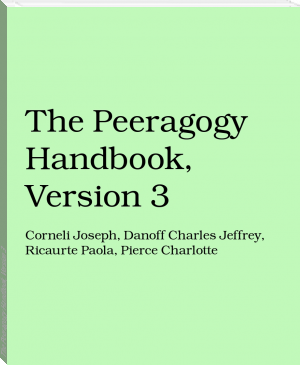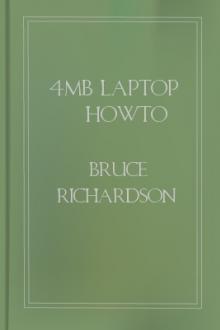The Peeragogy Handbook, Version 3, Corneli Joseph, Danoff Charles Jeffrey, Ricaurte Paola, Pierce Charlotte [ebook reader 8 inch TXT] 📗

Book online «The Peeragogy Handbook, Version 3, Corneli Joseph, Danoff Charles Jeffrey, Ricaurte Paola, Pierce Charlotte [ebook reader 8 inch TXT] 📗». Author Corneli Joseph, Danoff Charles Jeffrey, Ricaurte Paola, Pierce Charlotte
The next time Paola or someone else uses the handbook or workbook to run a workshop, she can say, “turn to this page, let’s answer this question, you have 10 minutes.” There are lots of places where the writing in the handbook could be made more interactive. One technique Paola and Amanda used was turning “statements” from the handbook into “questions.”
Crafting a visual identity
Amanda also put together the latest cover art, with some collaboration from Charlotte using inDesign. A more large-scale visual design would be a good goal for the 4th Edition of the book. Fabrizio Terzi, who made the handbook cover art for the 1st Edition, has been working on making our website more friendly. So, again, work is in progress but we could use your help.
Workflow for the 4th edition
We’ve uploaded the content of the book to Github and are editing the “live” version of the site in Markdown. For this and previous print editions, we’ve converted to LaTeX. There are a number of workflow bottlenecks: First, people need to be comfortable updating the content on the site. Second, it would be good to have more people involved with the technical editing work that goes into compiling for print. Remember, when we produce an actual physical handbook, we can sell it. In fact, because all co-authors have transferred their copyright in this book to the Public Domain, anyone can print and sell copies, convert the material into new interactive forms, or do just about anything with it.
Translations
Translating a book that’s continually being revised is pretty much a nightmare. With due respect to the valiant volunteer efforts that have been attempted so far, it might be more convenient for everyone involved to just pay professional translators or find a way to foster a multi-lingual authoring community, or find a way to create a more robust process of collective translation. Ideas are welcome, and we're making some small steps here. More on this below.
Next steps? What’s the future of the project?
In short: If we make the Handbook even more useful, then it will be no problem to sell more copies of it. That is one way to make money to cover future expenses. It’s a paradigmatic example for other business models we might use in the future. But even more important than a business model is a sense of our shared vision, which is why we’re working on a “Peeragogy Creed” (after the Taekwondo creed, which exists in various forms, one example is [2]). No doubt you’ll find the first version on peeragogy.org soon! Chapter 7 contains a further list of practical next steps for the project.
References
Joshua Schimel, 2012. “Writing Science”, Oxford University Press.
Taekwondo Student Creed, World Martial Arts Academy, http://www.worldtaekwondo.com/handbook.htm
☞ Welcome to the Peeragogy Workbook!
This booklet is designed to introduce you to our fun, exciting world of peer learning and peer production!! You may already be familiar with these terms, or they may be new to you. Either way, don't worry!!!
If they are new, consider the following 2 examples.
Peer learning: Joe Corneli needs to get from the suburbs of Chicago to the north side of the city. He gets on the commuter train and transfers to the purple “L” at Davis Street in Evanston. He plans to change to the red line at Howard Street, but the train says “Loop” and he asks another passenger whether it will stop at Howard. She says it will, but that he can save an hour of his time by riding express to the city and then coming back two stops! Joe makes it to his meeting with Charlie with plenty of time to spare.
Peer production: Two cavewomen see lightning strike a tree and produce fire! Walking up to it they notice the heat and think “Wouldn't it be nice to have fire for our family at night!” Once the rain clears, they find some dry sticks and start working together to figure out how they can use them to start their own flame. After hours of trial and error, BOOM they've got fire! The news travels fast. :)
Peeragogy is an approach to learning and working together on projects ranging from the mundane to the monumental. Peer learning and peer production are probably as old as humanity itself, but they take on new importance in the digital age.
The Peeragogy Project is an informal learning project with members worldwide. Three members of the project share their welcoming messages below.
Paola Ricaurte Quijano: Welcome to the Peeragogy Project! We are a group of enthusiastic people who love to learn and are trying to find the best ways to learn together.
Lisa Snow MacDonald: Welcome to peeragogy! It's kind of a weird name, but it's enormously powerful in providing a fresh understanding of ways of working together.
Dorotea Mar: Your contributions will be really welcome if you participate respectfully and harmoniously with other peers. It can change your life and improve your wellbeing and make everything better.
A Peeragogy Interview
Introductions
Paola Ricaurte Quijano: Hi! I'm Paola, I'm from Ecuador. I work at Tecnológico de Monterrey, a private university in Mexico City, and I love to learn with everybody!
Dorotea Mar: Hello. I'm in Berlin now and I really like the peeragogical atmosphere of collaboration and I think we are really improving ways of collaboration and peer production, so that's why I'm here.
Lisa Snow MacDonald: Hello. This is Lisa from Los Angeles. My background is media psychology and I'm interested in peeragogy as it relates to business.
What is peer learning/production?
PRQ Well, peer learning. learning with peers, learning from peers and trying to make things together or make things happen together. I think that for me, the most important thing I've learned from this experience is that you can achieve more when you work together and set goals together.
LSM I think what peeragogy does is it allows us to recognize the value of those connections. A lot of other ways of working are more individualized. It goes back to a concept of 1 + 1 = 2, which is very rational and very measured and is kind of a dominant way of thinking in our society today, whereas peer to peer learning and production recognize the value of those connections. You may not be able to measure it with a yardstick, but we understand that there is value in those connections. So it's basically acknowledging that when it comes to learning/collaborative environments if constructed the right way if working well it can be 1 + 1 = 3 or 1 + 1 = 4. That type of situation, which is really different from the way we're used to thinking about things. And I think that's really the value of what we're doing and the potential of what we could hopefully unlock.
More specifically, what is peeragogy and/or what is the Peeragogy Project?
PRQ This is a project that began spontaneously. We didn't have a plan at the beginning. We just talked about the things that concerned us the most. What do you need if you want to learn with others, how to learn better? what do you want to learn? Where do you want to learn? When do you want to learn? Basic questions that can be answered in many ways. We don't have a strict line. We have a map, maybe, but a map that can be walked through by many different paths. Paths that you choose can be related to the people you are working with. I think it's been a great experience for us. As Lisa said, we have been recognizing the talents and strengths of every person that has contributed to and participated in this project.
LSM OK. I'll take my best shot with this. Going back to what I said earlier and building off what other people have said. Because we don't have a good mental construct of how this works, and measurement is difficult. We haven't learned how to measure these connections. I think what peeragogy and the Peeragogy Project can do is it can establish what people have said about focusing on the process. It can help people understand the process better. Because this lack of structure can be uncomfortable for people. We need to understand when that discomfort is acceptable, so they don't revert and become counterproductive participants in the process. The map analogy that Paola just mentioned, is really good too. It's not about providing a direct path. If you're on a trip trying to get from LA to Chicago, there's many paths you can take. It's making sure you're monitoring your resources and you're taking care of things along the way. You can drift off-course. One plus one can equal zero if things don't work out well. So, what peeragogy and the Peeragogy Project can do is to provide some structure and framework around the unstructured way that things can be done. People trying to make sure their methods are constructive and beneficial now have some guidelines and things to watch out for.
Example: Howard Rheingold Grows a Learning Network
“When I started using social media in the classroom, I looked for and began to learn from more experienced educators. First, I read and then tried to comment usefully on their blog posts and tweets. When I began to understand who knew what in the world of social media in education, I narrowed my focus to the most knowledgeable and adventurous among them. I paid attention to the people the savviest social media educators paid attention to. I added and subtracted voices from my attention network, listened and followed, then commented and opened conversations. When I found something I thought would interest the friends and strangers I was learning from, I passed along my own learning through my blogs and Twitter stream. I asked questions, asked for help, and eventually started providing answers and assistance to those who seemed to know less than I. The teachers I had been learning from had a name for what I was doing — “growing a personal learning network.” So I started looking for and learning from people who talked about HOW to grow a “PLN” as the enthusiasts called them.”
How do you do peeragogy?
DM I think I do a lot of peeragogy and I'm very happy about it because I learn so much from my group and from myself in this group that I like to apply it to other projects that I'm in or things like coworking and coliving projects. Especially the principle of mutual respect that still remains after a very long time. And the way we relate to each other is really nice.
The main principle is mutual respect and openness, and the process. And in each detail, there is value that we believe in.
Let's say how we manage the Peeragogy Page or Community (See “How to Get Involved," later in this chapter.). These seem to be details, but they're actually really important. So if we pay attention to all these, every little thing matters, and this is how I do it. I try to be very mindful in all interactions.
image
Example: Learner, know thyself.
When he joined the Peeragogy project in 2012, Charles Jeffrey Danoff did a brief selfevaluation about what makes him interested in learning:
Context. As a student, I





Comments (0)